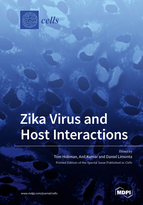Zika Virus and Host Interactions
A special issue of Cells (ISSN 2073-4409).
Deadline for manuscript submissions: closed (30 September 2019) | Viewed by 66441
Special Issue Editors
Interests: RNA virus; host interactions; RNA interference pathways
Interests: arboviruses; virus-host interaction; innate immunity
Special Issue Information
Dear Colleagues,
Zika virus is the mosquito-transmitted flavivirus that was responsible for a recent pandemic in the Americas. Brazil was at the epicenter of this outbreak and experienced an inordinate number of babies born with microcephaly and other neurological disorders. In addition to being a teratogenic agent, Zika virus infection is linked to increased risk of Guillain–Barré syndrome in adults. Although the virus was discovered over 70 years ago in Africa, prior to the 2015/2016 outbreak, very little was known about this pathogen. As such, neither specific therapeutic or prophylactic regimens are available to manage the disease. These factors led to a dramatic increase in research activity focused on Zika virus and in particular, development of vaccine candidates which are in various stages of clinical trials. While the pandemic in South and Central America has subsided, many parts of the world remain at risk for near term outbreaks due to the prevelance of mosquito vectors that transmit Zika virus and large dense urban areas with serologically naïve populations. Accordingly, to limit Zika virus-associated disease in future epidemics, it is imperative to further understand how this pathogen interacts with different host cell types.
The aim of this Special Issue of Cells is to showcase the latest research findings that advance our knowledge of how Zika virus targets cellular pathways to allow productive replication and establish persistence. It is anticipated that findings from these studies will lead to a molecular understanding of viral disease and form the basis for novel anti-viral therapies. We welcome submissions from the community that focus on all aspects of Zika virus–host interactions.
Prof. Tom Hobman
Dr. Anil Kumar
Dr. Daniel Limonta
Guest Editors
Manuscript Submission Information
Manuscripts should be submitted online at www.mdpi.com by registering and logging in to this website. Once you are registered, click here to go to the submission form. Manuscripts can be submitted until the deadline. All submissions that pass pre-check are peer-reviewed. Accepted papers will be published continuously in the journal (as soon as accepted) and will be listed together on the special issue website. Research articles, review articles as well as short communications are invited. For planned papers, a title and short abstract (about 100 words) can be sent to the Editorial Office for announcement on this website.
Submitted manuscripts should not have been published previously, nor be under consideration for publication elsewhere (except conference proceedings papers). All manuscripts are thoroughly refereed through a single-blind peer-review process. A guide for authors and other relevant information for submission of manuscripts is available on the Instructions for Authors page. Cells is an international peer-reviewed open access semimonthly journal published by MDPI.
Please visit the Instructions for Authors page before submitting a manuscript. The Article Processing Charge (APC) for publication in this open access journal is 2700 CHF (Swiss Francs). Submitted papers should be well formatted and use good English. Authors may use MDPI's English editing service prior to publication or during author revisions.
Keywords
- Zika virus
- virus–host interactions
- pathogenesis
- anti-viral signaling
- replication
- immune response
- virus evolution









